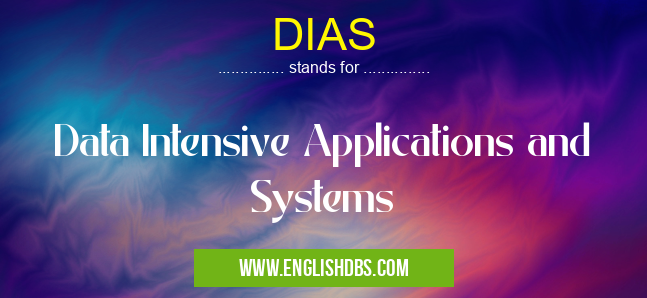What does DIAS mean in UNCLASSIFIED
DIAS stands for Data Intensive Applications and Systems. These applications and systems are characterized by their ability to manage and analyze vast amounts of data, often in real-time. They are becoming increasingly important in a wide range of industries, including healthcare, finance, and manufacturing.

DIAS meaning in Unclassified in Miscellaneous
DIAS mostly used in an acronym Unclassified in Category Miscellaneous that means Data Intensive Applications and Systems
Shorthand: DIAS,
Full Form: Data Intensive Applications and Systems
For more information of "Data Intensive Applications and Systems", see the section below.
Introduction to DIAS
Characteristics of DIAS
- High volume of data: DIAS typically handle large amounts of data, which can range from terabytes to petabytes.
- Real-time processing: Many DIAS are designed to process data in real-time, enabling businesses to make informed decisions based on the latest information.
- Data analytics: DIAS often include sophisticated data analytics capabilities, which allow users to identify trends, patterns, and insights from the data.
- Cloud-based: Many DIAS are hosted in the cloud, which provides scalability and cost-effectiveness.
Benefits of DIAS
- Improved decision-making: DIAS can provide businesses with valuable insights into their data, which can help them make better decisions.
- Increased efficiency: By automating data processing and analysis, DIAS can improve operational efficiency.
- New revenue streams: DIAS can enable businesses to develop new products and services based on the insights they gain from their data.
Examples of DIAS
- Healthcare: DIAS are used to manage electronic health records, analyze medical images, and develop personalized treatment plans.
- Finance: DIAS are used to detect fraud, manage risk, and make investment decisions.
- Manufacturing: DIAS are used to monitor production processes, optimize supply chains, and predict maintenance needs.
Essential Questions and Answers on Data Intensive Applications and Systems in "MISCELLANEOUS»UNFILED"
What is DIAS (Data Intensive Applications and Systems)?
DIAS refers to a category of applications and systems that require the processing and management of vast amounts of data. These systems often involve data analytics, machine learning, and artificial intelligence techniques to extract meaningful insights from large datasets.
What are the characteristics of DIAS?
DIAS typically exhibit the following characteristics:
- High data volume: They operate on datasets that can range from gigabytes to petabytes or even exabytes.
- Real-time or near-real-time processing: These systems can process and analyze data in near real-time to provide timely insights and decision support.
- Complex data structures: DIAS often handle data with complex structures, such as graphs, images, and unstructured text.
- Distributed computing: To handle massive data volumes, DIAS often employ distributed computing architectures across multiple servers or clusters.
- Scalability and flexibility: These systems are designed to scale seamlessly to accommodate growing data volumes and workloads.
What are the benefits of using DIAS?
DIAS offer numerous benefits, including:
- Improved decision-making: By leveraging large and diverse datasets, DIAS can provide deeper insights and support data-driven decision-making.
- Enhanced customer experiences: DIAS can personalize recommendations, improve customer service, and tailor marketing campaigns based on individual user behavior and preferences.
- New product and service development: Data analysis through DIAS can uncover hidden patterns and trends, leading to the development of innovative products and services.
- Scientific discovery and research: DIAS enable scientists and researchers to analyze vast amounts of data, facilitating new discoveries and advancements in various fields.
What are some examples of DIAS?
Common examples of DIAS include:
- Data analytics platforms (e.g., Hadoop, Spark)
- Machine learning and AI systems (e.g., TensorFlow, PyTorch)
- Cloud-based data warehouses (e.g., AWS Redshift, Google BigQuery)
- Social media platforms (e.g., Facebook, Twitter)
- Online marketplaces (e.g., Amazon, eBay)
Final Words: DIAS are becoming increasingly essential for businesses that want to stay competitive in the data-driven economy. They provide organizations with the ability to manage and analyze large amounts of data, in real-time, and gain valuable insights that can help them make better decisions.
